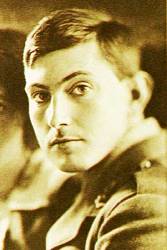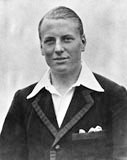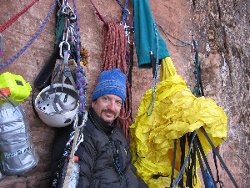
Left: George Mallory and Andrew Irvine © RGS/The Sandy Irvine Trust, from "Ghosts of Everest" ; Right: 1924 North Face locations © Pete
| Photoanalysis | Routes & Maps | Video & Books | Contact Me |


"I'm quite doubtful if I shall be fit enough. But again I wonder if the monsoon will give us a chance. I don't want to get caught, but our three-day scheme from the Chang La will give the monsoon a good chance. We shall be going up again the day after tomorrow. Six days to the top from this camp!"
--from George Mallory's last letter to his wife prior to disappearing on Mt. Everest with his partner Andrew "Sandy" Irvine in 1924
"My face is in perfect agony. Have prepared two oxygen apparatus for our start tomorrow morning".
- Sandy Irvine's last diary entry

About Me
 Celebrating my 50th birthday on pitch 3 of Prodigal
Son, Zion National Park, Utah (guided, all I did was jug up the ropes!)
Celebrating my 50th birthday on pitch 3 of Prodigal
Son, Zion National Park, Utah (guided, all I did was jug up the ropes!)
I am an Emeritus Professor of Chemistry at Western Oregon University where I taught for 31 years.

History of Mount Everest from 1903 - 1975 (copyright © 2005-2023)
Reference: "Everest" 3rd ed, by Walt Unsworth
Page 1 Page 2 Page 3 Page 4 Page 5 Page 6
1933: The Fourth British Expedition. A new generation of climbers attempts Everest under the Leadership of Hugh Ruttledge. These new climbers include Jack Longland, Frank Smythe, Eric Shipton, P. Wyn Harris, and L.R. Wager. Along with a powerful and spirited team of Sherpa "Tigers", Camp 6 is established on a ledge half-way up the Yellow Band at a height of 27,300 feet (8320 meters) - the Sherpas wanted to continue higher to a campsite at the base of the First Step, but it is wisely decided that they would not get back to the North Col before dark. Longland leads the Sherpas back down, but they are caught in a fierce and unexpected storm. Longland manages to keep his bearings and keeps the party en route down the spine of the North Arete. During the descent they discover the remains of the 1924 Camp 6, and even find a working battery-operated torch in the debris.
May 30th: The first oxygenless summit attempt by Wyn Harris and Wager. Their plan is to reconnoiter Mallory's ridge route, and if not feasible, attempt Norton's Great Couloir route instead. Early in the ascent they find Andrew Irvine's ice ax at 27,690 feet (8440 meters), some 250 yards (meters) east of the First Step. The pair continues traversing below the NE Ridge, but are unable to gain the Ridge via a shallow gully below the Second Step, having missed their only chance to gain the Ridge by ascending a 4th class gully on the north side of the First Step. They continue traversing into and across the Great Couloir, and manage to reach Norton's high point before admitting defeat.
June 1st: A second oxygenless attempt is made by Eric Shipton and Frank Smythe. In a truly superhuman effort, they make an attempt after spending two nights in the Death Zone without oxygen waiting for good weather. They follow essentially the same ascending line taken by Wyn Harris and Wager to the base of the First Step, but continue along Norton's traversing Great Couloir route. Shipton is forced to give up a little past the First Step, and Smythe continues alone, crossing the Great Couloir somewhat lower down than his predecessors where the ledges were more favorable. Smythe too gives up at Norton's high point, so the 1933 Expedition ends up unsuccessful.
1934: The eccentric Maurice Wilson attempts to solo Everest, having no mountaineering experience but possessing an inner faith to succeed. Camped at the base of the North Col, Wilson asks his Sherpas to wait ten days for him to return, after which they would be free to leave. He doesn't return, so the Sherpas return to Darjeeling, where Tenzing Norgay reports seeing them with large amounts of money. Wilson's body is later found at approximately 21,000 feet (6400 meters) below the North Col by members of the 1935 Reconnaissance Expedition. He was found in the remains of his tent; apparently he had died while in the act of taking off his boots. How far did he get? No one knows... His body was buried in a crevasse and it periodically resurfaces over the years as the East Rongbuk Glacier continues its steady advance downhill.
1935: Fifth British Expedition (Reconnaissance). A small post-monsoon expedition led by Eric Shipton, that was Tenzing Norgay's first trip to the mountain as a young porter. Expedition members include Bill Tilman, Dr. C.B.M. Warren, E.G.H. Kempson, L.V. Bryant, and E.H.L. Wigram. The expedition concentrates on exploring, surveying, and climbing in the Everest region (where off in the distance they can see that Everest is in perfect condition to climb). The party doesn't reach Rongbuk until early July, where coated in monsoon snow, the mountain is out of condition to climb. Nevertheless, since investigating the possibility of a post-monsoon attempt is one of the charges of the reconnaissance, they establish Camp III at the base of the North Col, where they find the remains of Maurice Wilson. On July 12 they reach the North Col with enough supplies for two weeks. Continuous monsoon snows prevent any further advance up the mountain, so the expedition splits into several groups that engage in an orgy of climbing and exploring in the region before returning to Darjeeling.
1936: Sixth British Expedition with Hugh Ruttledge returning as Leader. Also returning to Everest are Frank Smythe, Eric Shipton, P. Wyn Harris, E.G.H. Kempson, Dr. C.B.M. Warren, and E.H.L. Wigram along with two newcomers, P.R. Oliver and J.M.L. Gavin. Tenzing Norgay returns for his second expedition as a porter. For the first time, lightweight radio sets are taken to Everest. A large, strong, and experienced expedition with many hopes of reaching the top, it failed because of the early onset of the monsoon on May 25th. Interestingly enough, the only two expeditions to Everest that had a late monsoon were the '21 and '35 Reconnaissance!
1938: Seventh British Expedition. Led by Bill Tilman who advocated smaller, less expensive expeditions (although he is convinced to bring four oxygen sets along). Accompanying Tilman are Eric Shipton, Frank Smythe, C.B.M. Warren, P. Floyd, P.R. Oliver, and Noel Odell from the tragic 1924 expedition. Odell is now 47 years old, but extremely fit after climbing Nanda Devi in 1936 with Tilman. Returning yet again as a porter is the persistent Tenzing Norgay. Remembering the early onset of the monsoon suffered by the 1936 expedition, they arrive at Rongbuk early on April 6th and surprisingly find the mountain already clear of winter snow. Three weeks later Camp III is established below the North Col, but the weather is too cold and the party too ill to continue. They retreat to the Kharta Valley to recuperate at the lower altitude. When they returned to Everest a week later, the monsoon had unbelievably broken on May 5th and the mountain was covered in snow. Nevertheless a camp is placed on the North Col, and then Camp 6 is established on a scree slope below the Yellow Band at 27,200 feet (8290 meters). In back-to-back assaults, Smythe and Shipton are turned back by the deep snow, as are Tilman and Lloyd the next day. The expedition fails, but it had proved that a small expedition could place climbers in position for a serious summit bid.
1947: A successor to the old Everest Committee is formed - the Himalayan Committee of the Alpine Club and Royal Geographical Society.
1947: Canadian-born Brit Earl Denman attempts to illegally climb Everest from the North along with Sherpas Ang Dawa and Tenzing Norgay, the latter back after nine years for his fourth attempt on the mountain. After nearly being arrested by a Tibetan patrol en route, the trio reach the Rongbuk Monastery. Using Denman's woefully inadequate equipment, and suffering terribly from the cold, they reach the foot of the North Col but in a terribly weakened condition. After a feeble attempt on the lower slopes of the Col, they admit defeat and turn back. Denman is forced to walk part of the way back to Darjeeling in bare feet after his boots wear out. Amazingly the whole 600-plus mile (1000 km) roundtrip from Darjeeling to Everest and back took only five weeks by foot.
1950: In October the Communist Chinese invade Tibet, and Tibet falls under Chinese rule. Everest expeditions from the North are prohibited.
.

News
2019 Searches and Evidence that Irvine and the Camera Were Found by the Chinese in 1975?
 Along with Mark Synnott, Thom Pollard was part of the National Geographic 2019 search, as well as a member of the 1999 search that found Mallory's body. I recommend his Facebook page as well as his YouTube channel where he has been producing videos dealing with the new theories that are given below.
Along with Mark Synnott, Thom Pollard was part of the National Geographic 2019 search, as well as a member of the 1999 search that found Mallory's body. I recommend his Facebook page as well as his YouTube channel where he has been producing videos dealing with the new theories that are given below.
After his book "The Third Pole: Mystery, Obsession, and Death on Mount Everest" was published, Synnott uncovered resarch that seems to prove that Irvine and the camera were found by the Chinese back in 1975.
Let's not forget that Jake Norton was on a Discovery Channel search at the same time, but looking in a different place!
There were two films produced about these searches, and you can watch them here: Pollard/Synnott movie "Lost on Everest (Discovery+), and the Norton film Everest's Greatest Mystery (this is an Amazon Prime link, but the movie is available on AppleTV as well).
New Theories
 It has recently come to my attention the theories of Ajay Dandekar, a historian and a faculty member of Shiv Nadar University, Delhi. I find his theory that Irvine stayed behind in a sleeping bag while Mallory went to the summit to be highly questionable. Please see my two part series on why I think this is true: Part 1 and Part 2
It has recently come to my attention the theories of Ajay Dandekar, a historian and a faculty member of Shiv Nadar University, Delhi. I find his theory that Irvine stayed behind in a sleeping bag while Mallory went to the summit to be highly questionable. Please see my two part series on why I think this is true: Part 1 and Part 2
 He's been around for awhile, but you'll want to read Michael Tracy's thoughts of what happened to Mallory and Irvine, along with his repository of YouTube videos. He's very mercurial and you'll need a thick hide if you debate him!
He's been around for awhile, but you'll want to read Michael Tracy's thoughts of what happened to Mallory and Irvine, along with his repository of YouTube videos. He's very mercurial and you'll need a thick hide if you debate him!
New Mallory and Irvine Forum hosted by Jake Norton
 Please visit and become a member of Jake Norton's new Mallory and Irvine forum. You'll want to check out his image-based collection of all of the searches for Irvine from 1999 to 2019. He also has a three part series on his theory of what happened to Mallory and Irvine: part 1, part 2, part 3. And finally, here is the link to his Mallory and Irvine archive.
Please visit and become a member of Jake Norton's new Mallory and Irvine forum. You'll want to check out his image-based collection of all of the searches for Irvine from 1999 to 2019. He also has a three part series on his theory of what happened to Mallory and Irvine: part 1, part 2, part 3. And finally, here is the link to his Mallory and Irvine archive.

Articles and Editorials
A new article by researcher Wim Kohsiek, who has convincingly interpreted the time Mallory's watch was pointing to when it stopped, at odds with Jochen Hemmleb's interpretation that it was pointing to the time of Odell's sighting of the pair at 12:50 pm.
An interview with Graham Hoyland, author of the new book “Last Hours on Everest - The gripping story of Mallory and Irvine's fatal ascent”
Harvey V. Lankford, MD, has written a paper documenting the origin of the term "Glacier Lassitude" as a diagnosis for the debilitating effect of altitude as experienced by members of the early British Everest expeditions.
My new "what if?" theory about Mallory and Irvine's last climb, where I assume Odell's sighting was erroneous, and have them taking the Couloir route instead.
Part 1: the ascent
Part 2: the descent
Warwick Pryce is a new researcher who has arrived on the scene, and he has a new theory about how Andrew Irvine could have been the first person to stand on the top of the world.
Wim Kohsiek has a new interpretation of what Mallory's altimeter can tell us based on scientific applications of meterology.
Mallory and Irvine researcher Wim Kohsiek has two new thought-provoking articles about Mallory's watch and Irvine's location:
Mallory's Watch - Does it Really Point to 12:50 PM?
1924 Oxygen by Richard McQuet and Pete Poston
Why the Camera and Film are not Doomed to Destruction!
The Politics of Mallory and Irvine
Why Andrew Irvine Will Not be Found in a Sleeping Bag! Part 1 and Part 2
Chomolungma Nirvana: The Routes of Mount Everest
Rust Marks on Mallory's Altimeter
Little Known Free-Solo Ascent of the Second Step in 2001 by Theo Fritsche - I should never have written this - Anker and Houlding deserve credit for the first free ascent
Criticisms of the 2004 EverestNews.com search for Irvine --
The Mystery of Mallory and Irvine's Fate (with J. Hemmleb): Part 1, Part 2, Part 3, Part 4, Part 5.
Mallory and Irvine - Comments on the 'real Second Step' route: Part 1 and Part 2
Conrad Anker's comments on the unlikeliness of a direct route up the prow of the 2nd Step
Articles about my heroes Walter Bonatti and Chris Bonington --
Spilling the Beans - Lino Lacedelli's Book "Price of Conquest: Confessions from the First Ascent of K2" Part 1 and Part 2
The Life and Climbs of Chris Bonington, Part 1, Part 2, Part 3, Part 4, Part 5 final - interview
|
Copyright (c) 2004-2022 Pete Poston. All rights reserved. Visitor's Agreement |